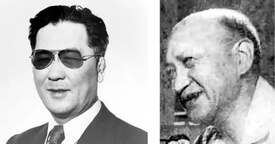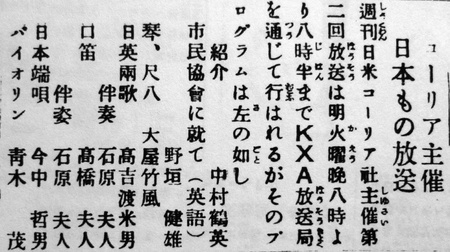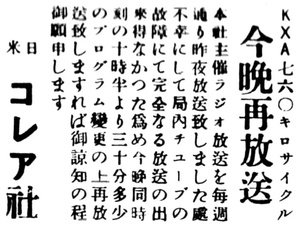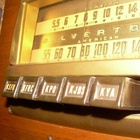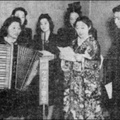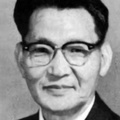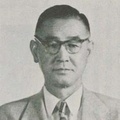Japanese American Courier Broadcasting
The Japanese American Courier (hereafter referred to as the Courier) was an English-language weekly newspaper (President: James Sakamoto) that was launched in Seattle in January 1928 and targeted at second-generation Japanese, and was published every Saturday. It initially only covered the Seattle area, but later expanded its reach to the West Coast.
A radio program sponsored by this English-language newspaper began on KXA in February 1934 (it was renamed KOL and KJR for a time). It was a 30-minute program that aired every Tuesday at 8 p.m. and was officially called "Our Japanese Community." It was mainly in English, with occasional Japanese used. The announcer was Nakamura Tsurue, who also worked as an actor. Nakamura was known by the nickname Tura, as the name "Tsurue" was difficult for Americans to pronounce. In Nakamura's absence, Courier editorial staff members Kanazawa Toru (English) and Ishigami Denzo (Japanese) were in charge of the announcements. Ishigami appeared on the program performing rakugo, naniwabushi and other genres, and was a familiar face to listeners.
The original program consisted of three parts: live performances by local classical, Western and Japanese artists, performances on records sent from Japan, and speeches.
In the field of music, a diverse range of talents gathered, including the violin prodigy Tamotsu Miwako, Hannah Kosaka Iso, who led the Aeolian Choir, shakuhachi masters Kurimoto Ryuzan, Hotta Shuzan, and Oya Chikufu, shamisenist Ike Tsuyako and Tanaka Misuro, koto player Mary Nishimura and Mrs. Ishida, nagauta performers Kondo Hideko and Kimura Kenji, enka performers Miyashita Jinzo and Imanaka Tetsuo, and vocalists Mochizuki Waka and Miyagawa Chizuru. Also appearing from The Courier were advertising editor John Funai (enka) and sports columnist Takayoshi Tomei (vocals).
In June 1934, a new attempt was made: a "Current Affairs Commentary" in Japanese, written by Terumitsu Kano of the Daihoku Nippo. After about a month, it was replaced by an English news item called the "Courier (News) Bulletin." The news was five minutes long, and it was said that it always tried to include something favorable to Japan. Later, it became a section called the "News Bulletin and Club Notes," which, in addition to news, also carried information on Japanese-American meetings. It seems that this was intended to overcome, at least to some extent, the handicap of a weekly newspaper, which made it difficult to follow the latest news due to deadlines. This news section was written by four members of the Courier's editorial staff: Toru Kanazawa, Bill Hosokawa, Jack McGillivray (real name John), and Susumu Kobayashi. Later, Hosokawa became a journalist and author, McGillivray a university professor, and Kobayashi an announcer for overseas broadcasts by the Japan Broadcasting Corporation.
Music records were also used, but there was little advance notice of whose songs would be played. However, an exception was made for Ricky Miyagawa, a Seattle-born jazz singer who debuted in Japan in 1934 as an exclusive Columbia jazz singer, whose songs were introduced in advance as "a record-breaking record" and "a hit song in Japan."
From 1936 to 1939, Naniwabushi records were played almost every week. At the time, Naniwabushi was extremely popular among Japanese society, and performances by performers such as Sakai Un and Suzugi Yonewaka, who toured the United States, as well as Kimura Tomoe and Tenchuken Ungetsu, were often featured.
From July 1938 onwards, lectures and speeches became a regular feature, featuring appearances by University of Washington faculty, students, alumni, members of the Japanese American Citizens League (JACL), and members of local high schools. In particular, University of Washington professor Henry Tatsumi and his wife, who had just returned from a trip to Japan, JACL members such as Tom Ise and Clarence Arai, Kenji Ito, who ran a law firm in Seattle, Jack McGillivray, who became a lecturer at University of Washington after studying in Japan for two years, and journalist Robert Hosokawa stood in front of the microphone on numerous occasions.
If we classify the contents of the lectures, most of them were themes introducing Japan, such as Japanese literature (Lafcadio Hearn, The Tale of Genji, Hototogisu), famous Japanese people (Shinran Shonin, Fukuzawa Yukichi, Noguchi Hideyo), and current affairs in Japan (modern Japanese theater, the school system, abacus, banking system, sports, the year 2600, Japan-US trade, the development of Japanese culture, Japan - yesterday and today, American-born Japanese people in Tokyo, Japanese journalism, Japanese news agencies).

In addition, Seattle Maryknoll Church, which was engaged in missionary activities targeting Japanese people under the leadership of Father Leopold Chibesar, broadcast many church programs, starting with a program about the National Catholic Charities Conference on August 4, 1936. The program that the church put the most effort into was a program related to the anniversary (February 5) of the martyrdom of 26 Catholics who were crucified in Nagasaki by order of Toyotomi Hideyoshi. From 1937 onwards, various programs were produced before the anniversary, such as an opera about "religious samurai" and the stories of the 26 saints. In addition, a discussion between Father Chibesar and university professors about Louis Adamic's book "From Many Countries (A Young American with a Japanese Face)" was also broadcast.
The radio program announcements in the Courier disappeared with the episode broadcast on June 26, 1941. Since there was no article announcing the cancellation or end of the program, it is unclear why it was canceled. It is thought that the radio station probably notified them that they would no longer broadcast the program due to the deterioration of Japan-U.S. relations before the outbreak of the Pacific War. The last Japanese program in Seattle had gone out five months before the outbreak of war between Japan and the U.S.
*This article is an excerpt from Japan Hour (2020) and reprinted from North American Newspaper (February 23, 2022).
© 2020 Tetsuya Hirahara


